A first guide to classic 20th century racing bikes
Posted: Friday 26th June 2020
There is no such thing as an uncool bike…it can be old, in which case it’s a classic, and everyone will want one (that’s why idiots pay huge sums on eBay for any bit of #*∂+ with an Italian name and a bit of chrome on it). ‘Dr. Hutch’, Cycling Weekly (October 15, 2009, page 76)
These rather ambivalent, if mildly vulgar, sentiments expressed by an influential columnist in a leading cycling magazine (‘Dr. Hutch’ is in reality Michael Hutchinson, a top 21st century British time trialling champion) probably reflect those of many modern cycling enthusiasts: they may admire and be interested in old racing bikes and equipment dating from the 20th century but lack the knowledge necessary to appreciate them fully. This guide aims to provide a quick and easy basis for doing so.
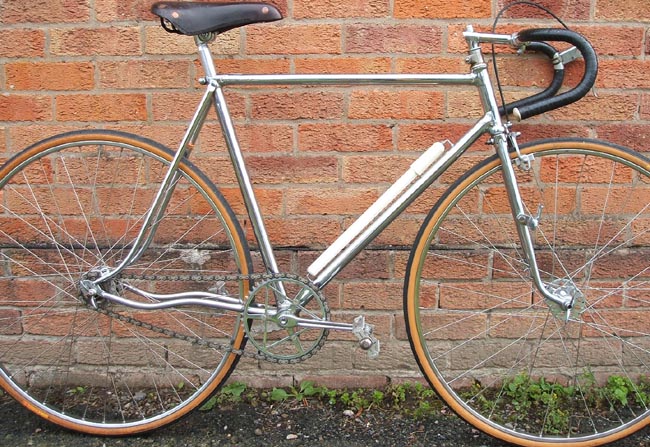
It seeks to clarify the main features of classic 20th century racing bicycles, thereby providing an entrée into what many may currently consider to be a largely opaque world which is the exclusive province of aficionados or, in Dr. Hutch’s lexicon, ‘idiots’.
It does so by focusing on a series of obvious questions that interested newcomers are likely to ask, such as:
• Why the current interest in 20th century racing bicycles?
• How can one recognise a classic bike?
• What are the main types of racing machines?
• Who were the main producers of these?
• What materials were used in their construction?
• Which are the most prized machines and why?
• Who really built the bicycle frames?
• What about the equipment: saddles, gears, pedals and the like?
• How can dates of manufacture and the names of manufacturers be established?
• How can more be learnt about all these matters?
Here goes!
Why the current interest?
To understand this it is necessary to understand something of the evolutionary history of the racing bicycle.
Throughout the 20th century the racing bike, particularly the road version as raced in events like the Tour de France, underwent rapid technological development but until the 1980s one important element remained constant: the racing frame and forks continued to be constructed exclusively from seamless, round steel tubing. Assembly methods of steel frames varied, with frame tubes (which themselves underwent increasing refinement until Reynolds 531 ‘butted’ tubes literally became their apotheosis) being either brazed into steel connecting lugs or ‘fillet–brazed’/bronze welded and therefore lugless.
Both methods are labour intensive and, at a minimum, require skilled artisans capable of producing rigid frames in which both wheels run in precisely the same plane. Steel racing bicycle frame building has been described as ‘…not much more than super–accurate plumbing…’ but with the qualification that:
has penetrated the entire joint and being able to estimate and minimize
the effects of expansion and contraction.
(R. Watson and M. Gray, 1978, The Penguin Book of the Bicycle, page 204).
Beginning in the 1980s, however, primarily in pursuit of greater lightness without sacrificing strength, racing frame builders began to experiment with new materials. Aluminium frame tubes were used first, initially being either glued (as in French ‘Vitus’ frames) or both glued and screwed into aluminium lugs (as with ‘ALAN’ frames from Italy). Then aluminium tubes were TIG welded together to form lugless frames.
At the same time, others (like ‘Litespeed’ in the US) began to experiment with titanium tubes while front forks moulded from carbon fibre were introduced (‘Look’ in France being the pioneers). Carbon main tubes secured to cast alloy lugs represented a further variation as did a carbon rear triangle married to an alloy main frame. Ultimately, entirely moulded carbon fibre frames and forks were developed and these became increasingly commonplace in the early 21st century to the point where they currently represent the norm in racing circles.
What this points to is a rapid and fundamental change in the technology of producing racing bicycle frames in the late 20th century. Accompanying this was a dramatic geographic relocation of manufacturing. In the space of a few decades, the shift was from the traditional one of skilled artisans, concentrated primarily in Britain, Italy and France, assembling steel tubes using hand held brazing torches to technicians, mainly in Asian countries like Taiwan, moulding frames from synthetic materials which are then cured by heat in an autoclave.
As a result, in the early 21st century the occidental industrial art of producing lightweight steel racing frames all but evaporated as worldwide demand for these declined. In the process, most of the enterprises but especially those which produced made–to–measure rider specific quality steel racing frames virtually disappeared along with the equipment associated with these machines. However, the period machines, frames and equipment themselves have, to a greater or lesser extent, survived in all of the countries in which competitive cycling was practiced in the 20th century. It is these that are prized by contemporary enthusiasts and collectors.
The reason is simple: we shall not see their like again.
How will I recognise a classic 20th century racing machine when I see one?
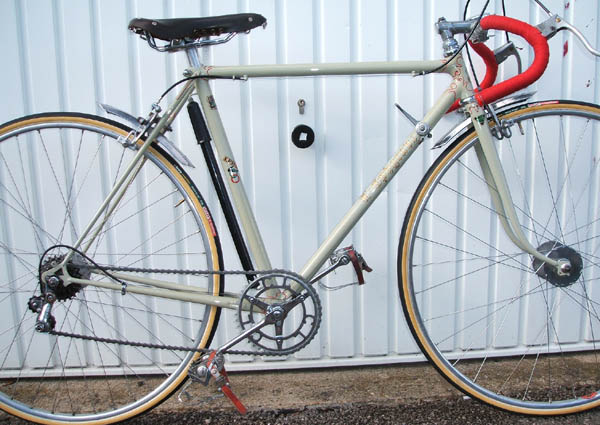
The simple answer is to look out for the following features:
• Drop ‘racing’ handlebars, narrow tyres and a narrow (leather) saddle
• Frame either lugged (often cut in various patterns) or lugless
• Distinctive frame colour and contrasting colour bands on main tubes and/or head tube
• Light weight and minimalist appearance (no chain guard or mudguards)
• Maker’s name transfers on frame down tube and badges on head tube and seat tube
• Metal racing pedals, toeclips and straps
• Small transfers on the frame referring to steel tubing (e.g. Reynolds 531; Columbus)
• Patterned lugs lined in colour and frame number (under bottom bracket or on rear end)If, on inspection, the machine exhibits all or many of these features there is a good chance that it is a steel racing classic. (It is also important to note, however, that the frame may have been repainted and carries no distinguishing transfers or decals). What follows will help you in further appreciating it.What are the main types of racing machines?Three types of racing machines were produced during the 20th century: Road, Track and Path. The latter type was exclusive to Britain and used mainly in fixed–distance time trialling events on the road (10, 25, 50 and 100 miles). Path machines had rear facing ‘track’ rear ends and were fitted with a single fixed gear and a front brake but could potentially also be used for track racing (including on flat grass tracks) once stripped of the brake. Table 1 summarises these matters.
Table 1. Types of classic racing bicycle
| Type | Road | Track | Path |
| Wheel clearances | Generous; road ends | Tight; track ends | Generous; track ends |
| Gearing | Multiple freewheel derailleur; double chainwheel | Single fixed cog | Single fixed cog; occasionally rear hub gear (fixed) |
| Brakes | Front and rear cable operated | None | Front - cable operated |
| Raced on | Open roads | Cycling tracks | Road and track |
The 20th century bicycle manufacturers best known to the general public are ‘Raleigh’ from Britain, ‘Bianchi’ from Italy and ‘Peugeot’ from France.
But while all three were historically associated with champion professional cyclists of the day like Reg Harris, Fausto Coppi and Eddy Merckx these sponsors were all essentially large scale mass–production bicycle companies. They did produce racing machines in limited numbers but this was not their stock–in–trade.
Rather, 20th century racing machines were produced mainly by both medium–sized companies and small enterprises (the latter often involving only one or two staff). Table 2 gives some indication of these three divisions and leading examples of each. The small enterprises produced only racing machines made to order for individual customers. In contrast, the medium–sized manufacturers produced ‘off–the–peg’ frames in different standard sizes (measured from the centre of the bottom bracket to the top of the top tube [British] or centre of the top tube [Continental]). These were then built up into complete machines and distributed to dealerships for sale to members of the general public.
| Mass–producers (with racing links) | Britain Hercules RaleighItaly BianchiFrance Gitane Motobecane Peugeot |
| Medium–sized producers (off–the–peg) | Britain Claud Butler Carlton Hobbs of Barbican Holdsworth Rotrax Sun VikingItaly Cinelli Frejus LegnanoBelguim Eddy Merckx Flandria |
| Small, exclusive builders (made–to–measure) | Britain Condor Ellis Briggs Ephgrave Hetchins Jack Taylor Mal ReesItaly Colnago Masi Pinarello Pogliaghi |
* It should be noted that some of these companies or ‘marques’ started out as small builders but subsequently expanded while others were subject to takeovers by larger producers.
Also, some off–the–peg builders did produce made– to–measure frames for individuals while some small builders
created frames for top sponsored riders which were then painted in their sponsors’ liveries.
In short, the boundaries between these categories were both porous and often crossed.
What materials were they made of?
The steel tubing used for building classic racing machines was most likely to be either British ‘Reynolds 531’ or Italian ‘Columbus’. Less likely are ‘Accles & Pollock’, ‘Vitus’ or ‘Tange’ tubing. If the frame you encounter has its original finish it will invariably carry small transfers indicating the make of tubing used in its construction. Different grades of tubing were produced by all tubing manufacturers, some being lighter than others. All, however, were double butted – that is, thicker inside at either end of the tube both for greater strength and to facilitate brazing which was accomplished by heating the tubes at the joints.
On lugged frames, Nervex lugs, especially the ‘Professional’ model, were used extensively on classic frames. Manufactured in France, these lugs were widely used by British frame builders but also by some Italians. They are decoratively cut lugs to a standard design with a distinctive ‘fishtail’ at the centre. Continental frames generally tend to have simple plain lugs whereas some British frames, like Hetchins, have elaborately patterned ‘baroque’ style lugs with various cut outs.
Regardless of where they were produced, the lugs on classic steel frames are generally filed down to a minimum at the points where these meet the frame tubes.
Which are the most prized machines today and why?
This question is difficult to answer because there are ‘marque enthusiasts’ who are interested in particular makes of frames (like Hetchins, Hobbs of Barbican and Ephgrave), ‘rarity enthusiasts’ who seek out unusual steeds and those more interested in machines ridden by past champions. In short, tastes vary.
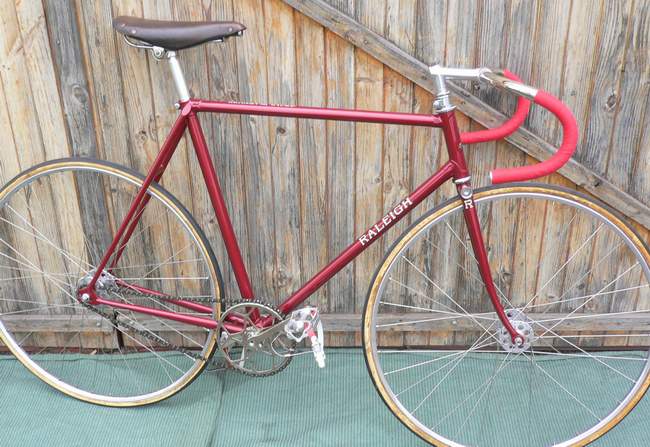
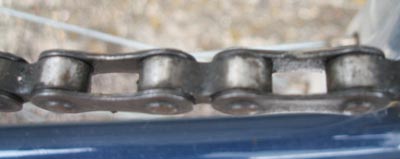
Each grouping overlaps to a certain extent – for instance, a1950s Raleigh track machine is a rarity but if it was also once ridden by the British sprint ace Reg Harris it has huge cachet.
As a general rule, therefore, if you can establish that a frame or machine is a classic, then as a first step it deserves to be admired and respected in its own right. The next step is to research it further.
Who really built the bicycle frames?
The name on the down tube is not invariably as indication of where it was built, much less who built it.
(R. Watson & M. Gray. 1978. The Penguin book of the Bicycle. P. 200).
This remains a much–vexed question with rumours surrounding some famous marques, it being suggested that certain reputed ‘master builders’ outsourced the building of most or all of ‘their’ badged frames. However, not all establishments hid this fact.
Medium–sized builders certainly employed numerous skilled staff and operated production lines of various types. Thus some personnel might build the frame diamonds, others the forks, others again attend to the spray painting and yet others build the wheels and assemble the complete machines. Without some variant of this production line system they could not have produced the number of machines which they did.
Exclusive builders who produced made–to–measure frames to order, on the other hand, involved only one or a few people. For instance, in Britain Jack Taylor Cycles consisted of three brothers who worked together to produce bespoke solo and tandem machines all bearing the ‘Jack Taylor’ name. In Italy, Sante Pogliaghi worked alone with a teenage apprentice to produce road, track and tandem machines.
In addition, some frame builders who had originally trained with medium–sized firms subsequently set themselves up as independent frame builders under their own names while also building frames ‘on the side’ for specialist shops. In Britain for instance there is the case of the celebrated frame builder, the late Bill Hurlow. Having trained as a frame builder at Holdsworth, he later built ‘Hurlow’ labelled frames while also supplying frames badged by Condors and Mal Rees both in London (see images below).
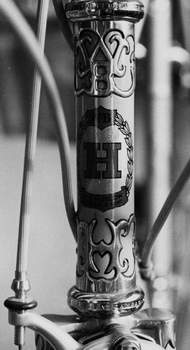
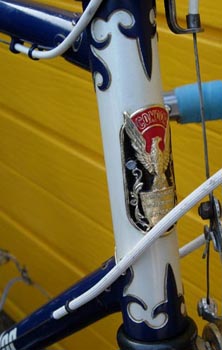
It is thus not always easy to determine exactly who built what. Suffice to say that all classic machines were the product of skilled artisans who invested many hours of labour in constructing the frames.
What about the equipment: saddles, gears, pedals and the like?
These are all major topics in their own right. However, some general guidelines can be given to each. Table 3 offers a quick guide to various leading types of equipment likely to be found on classic lightweights together with brand names to look out for on these.
| Items | Characteristics | Brands | Comments |
| Saddles | Leather: Plastic: | Brooks B17 Ideale* Mansfield Cinelli Concor Unica Nitor | *French; others all British All Italian |
| Brakes | Side pull Centre pull | Campagnolo GB* Universal GB Mafac* Resilion Universal Weinmann** | *British; others Italian *French **Swiss |
| Derailleur gears | Rear (3,4,5 speeds) Front (double chainwheel) | Campagnolo* Cyclo Benelux Huret** Osgear Simplex** Zeus*** Campagnolo* Cyclo Benelux Huret Simplex Zeus* | *Italian **French ***Spanish Others British *cable control; others rod control |
| Chainwheels & cranks | Cottered Cotterless | BSA Chater Lea Gnutti* Magistroni* Williams Campagnolo Stronglight* TA* Williams Zeus** | *Italian; others British *French **Spanish |
| Pedals | Cage type in steel/alloy plus toeclips & straps | Brampton Constrictor/BSA Campagnolo Chater Lea Lyotard* Zeus | *French |
| Handlebar assemblies | Steel or alloy bars Stems/extensions (alloy or steel) | Cinelli* GB Cinelli* GB Magistroni* | *Italian *Italian |
| Wheels (Diameters: 700mm, 27” & 26”) | Hubs (large & small flange; road=quick release). Alloy or alloy/steel bodies Rims– alloy (tubulars & high pressure/ clinchers) | Airlite Campagnolo FB Harden Pelissier* Zeus Constrictor* Fiamme Mavic** Nisi Weinmann*** | *French; others Italian, British and Spanish *British **French ***Swiss Others Italian |
How can dates of manufacture and the names of manufacturers be established?
Old racing frames and machines frequently turn up which have either been repainted or have deteriorated to the point where their makers’ names cannot be readily determined. Sometimes it is possible to infer this from the lugs and other frame details. If the name of the maker can be established then serial numbers can be used to determine the date of manufacture. Most of the lightweight machines that are still around today date from the period immediately following World War II and particularly from the 1950s and early 1960s. Thereafter, demand slumped and many famous names ceased production.
Frame numbers are usually stamped either under the bottom bracket or on the rear ends (typically the left one). However, finding a frame number alone is of little help in determining the frame’s maker as different builders used different systems. Frame numbers are only codes and many of these are indecipherable.
If, therefore, you think that the neglected, anonymous rusty old steed you have stumbled across is a rare racing machine handcrafted by an old master frame builder for a famous champion of the past…you are probably wrong! On the other hand, given determined detective work, you may be able to discover much about it.
How can more be learnt about all these matters?
This guide is at most only a beginning. To explore the world of classic lightweight bicycles further, the best place to start is with the two pre-eminent internet websites, namely:
classiclightweights.co.uk and classicrendezvous.com
These also provide invaluable links to other specialist lightweight websites. So, start surfing the net!
Geoff Waters (2010)
Posted: Friday 26th June 2020
Contents
- Introduction
- Real classic
- Racing bicycle
- Steel racing bicycle frame
- Litespeed
- Classic lightweight
- Classic racing bicycle
- Types of classic racing bicycle
- Main producers
- Table 2. Selected leading 20th century bicycle manufacturers*
- Materials used
- Track machine
- Frames
- Hurlow frame
- Classic lightweight equipment
- Details of classic lightweight equipment
- Manufacturers
This article appears in the following categories.
Upcoming Events
Whether you are looking for a gentle social meet up, or a 100-mile ride browse the community’s upcoming events and plan your next weekend outing.
